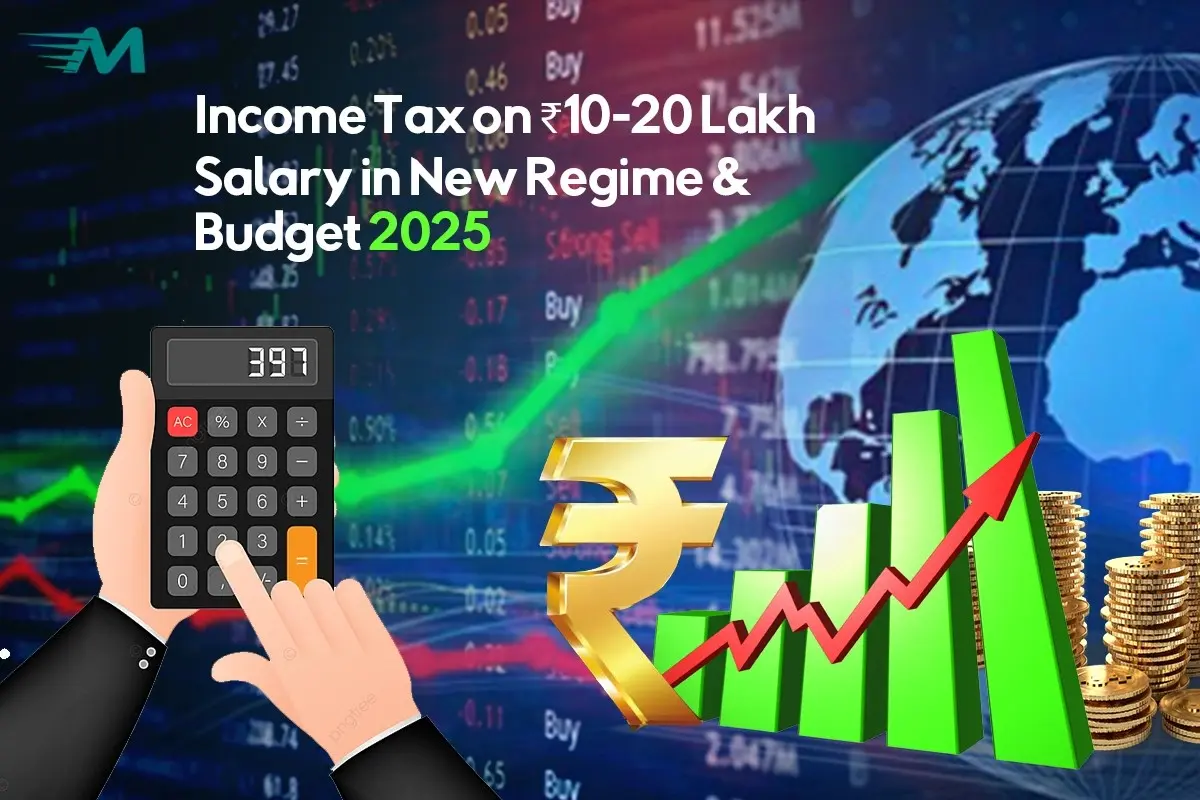Income Tax on ₹10-20 Lakh Salary in New Regime & Budget 2025
Taxpayers who earn between ₹10-20 lakh want to know their tax responsibility after the implementation of Budget 2025 income tax system. The government implemented various tax adjustments to enhance regulatory ease and boost available money for disposable use. The knowledge regarding both latest income tax slabs 2025 and available tax benefits 2025 helps people in your income category with tax computation and financial planning. The article provides details on income tax slab 2025-2026 together with tax payment amounts and new tax benefits for taxpayers.
Latest Income Tax Slabs 2025 Under New Regime
The new income tax regime introduced lower tax rates while removing most deductions. Budget 2025 further refined this structure, making it attractive for taxpayers who prefer a simpler filing process.
Here’s a breakdown of the income tax slab 2025-2026 under the new tax regime:
New Income Tax Slabs for FY 2025-26
| Annual Income (₹) | Tax Rate (%) |
| Up to ₹3,00,000 | Nil |
| ₹3,00,001 – ₹6,00,000 | 5% |
| ₹6,00,001 – ₹9,00,000 | 10% |
| ₹9,00,001 – ₹12,00,000 | 15% |
| ₹12,00,001 – ₹15,00,000 | 20% |
| Above ₹15,00,000 | 30% |
Key Changes in Budget 2025 Income Tax
First of all, let’s go and increase the basic exemption limit from ₹2.5 lakh to ₹3 lakh. The standard deduction of ₹50,000 has been kept in the new taxing regime. Subsidy under Section 87A has been further extended so that persons having an income of up to ₹7 lakh are exempt. This comes to tax relief being given to senior citizens, directly reducing a retiree’s tax burden.
Income Tax Calculation for ₹10-20 Lakh Salary in 2025
Let’s break down how much tax you will pay if your salary falls between ₹10 lakh and ₹20 lakh under the new income tax regime.
Example 1: Income Tax on ₹10 Lakh Salary
| Income Component | Amount (₹) |
| Gross Salary | 10,00,000 |
| Standard Deduction | (-) 50,000 |
| Taxable Income | 9,50,000 |
Tax Breakdown
- 0% on ₹3,00,000 = ₹0
- 5% on ₹3,00,001 – ₹6,00,000 = ₹15,000
- 10% on ₹6,00,001 – ₹9,00,000 = ₹30,000
- 15% on ₹9,00,001 – ₹9,50,000 = ₹7,500
- Total Tax = ₹52,500
After applying the rebate under Section 87A, if eligible, the final tax can be lower.
Example 2: Income Tax on ₹15 Lakh Salary
| Income Component | Amount (₹) |
| Gross Salary | 15,00,000 |
| Standard Deduction | (-) 50,000 |
| Taxable Income | 14,50,000 |
Tax Breakdown
- 0% on ₹3,00,000 = ₹0
- 5% on ₹3,00,001 – ₹6,00,000 = ₹15,000
- 10% on ₹6,00,001 – ₹9,00,000 = ₹30,000
- 15% on ₹9,00,001 – ₹12,00,000 = ₹45,000
- 20% on ₹12,00,001 – ₹14,50,000 = ₹50,000
- Total Tax = ₹1,40,000
Example 3: Income Tax on ₹20 Lakh Salary
| Income Component | Amount (₹) |
| Gross Salary | 20,00,000 |
| Standard Deduction | (-) 50,000 |
| Taxable Income | 19,50,000 |
Tax Breakdown
- 0% on ₹3,00,000 = ₹0
- 5% on ₹3,00,001 – ₹6,00,000 = ₹15,000
- 10% on ₹6,00,001 – ₹9,00,000 = ₹30,000
- 15% on ₹9,00,001 – ₹12,00,000 = ₹45,000
- 20% on ₹12,00,001 – ₹15,00,000 = ₹60,000
- 30% on ₹15,00,001 – ₹19,50,000 = ₹1,35,000
- Total Tax = ₹2,85,000
Tax Benefits 2025: Maximizing Your Savings
Many standard deductions are removed in the new income tax regime; however, some remains:
- Standard Deduction of ₹50,000 for salaried individuals.
- Higher exemption for senior citizens to lessen tax liability.
- Employers’ contribution to NPS continues to enjoy tax benefits under 80CCD(2).
- Rebate under Section 87A makes income tax-free up to ₹7 lakh.
Should You Choose the New Regime or Old Regime?
So, if you prefer to pay low taxes without deductions, the new tax regime suits you. On the other hand, if you have a lot of investments in PPF, NPS, EPF, or housing loans, the old tax structure can be more advantageous.
Who Should Opt for the New Regime?
Before advancing further or into further detail, an appropriate fit should be decided on for each of the following programs.
Who Should Stick to the Old Regime?
- Heavy claimants under Section 80C and HRA.
- Taxpayer homebuyers reaping interest deductions on housing loans.
- Taxpayers investing in ELSS, NPS, and insurance policies have their funds cut out for contributions.
Conclusion
It is vital to grasp the income tax slab of 2025-2026 and the associated income tax changes of the 2025 Budget to secure the most tax savings. The new income tax regime is simple with lower rates, but it takes away most of the exemptions. You can reduce liabilities while creating savings by availing yourself of the applicable tax benefits in 2025 and choosing an appropriate tax structure. Hence, before selecting which tax regime suits you best, consider your financial goals.
FAQs
1. What will be the tax rate in the case of a salary of ₹10 lakh for the assessment year of 2025?
Under the new income tax regime, the tax liability on a ₹10-lakh salary is ₹52,500 with the standard deduction factored in.
2. What new tax benefits will be introduced through the Budget 2025?
Yes, the Budget of 2025 has increased the basic exemption limit to ₹3 lakh and kept the standard deduction of ₹50,000.
3. Is it possible to switch between the old tax regime and the new tax regime?
Yes, salaried individuals may make a switch every year, while those in the business must remain in one regime until permanently exiting from it.



